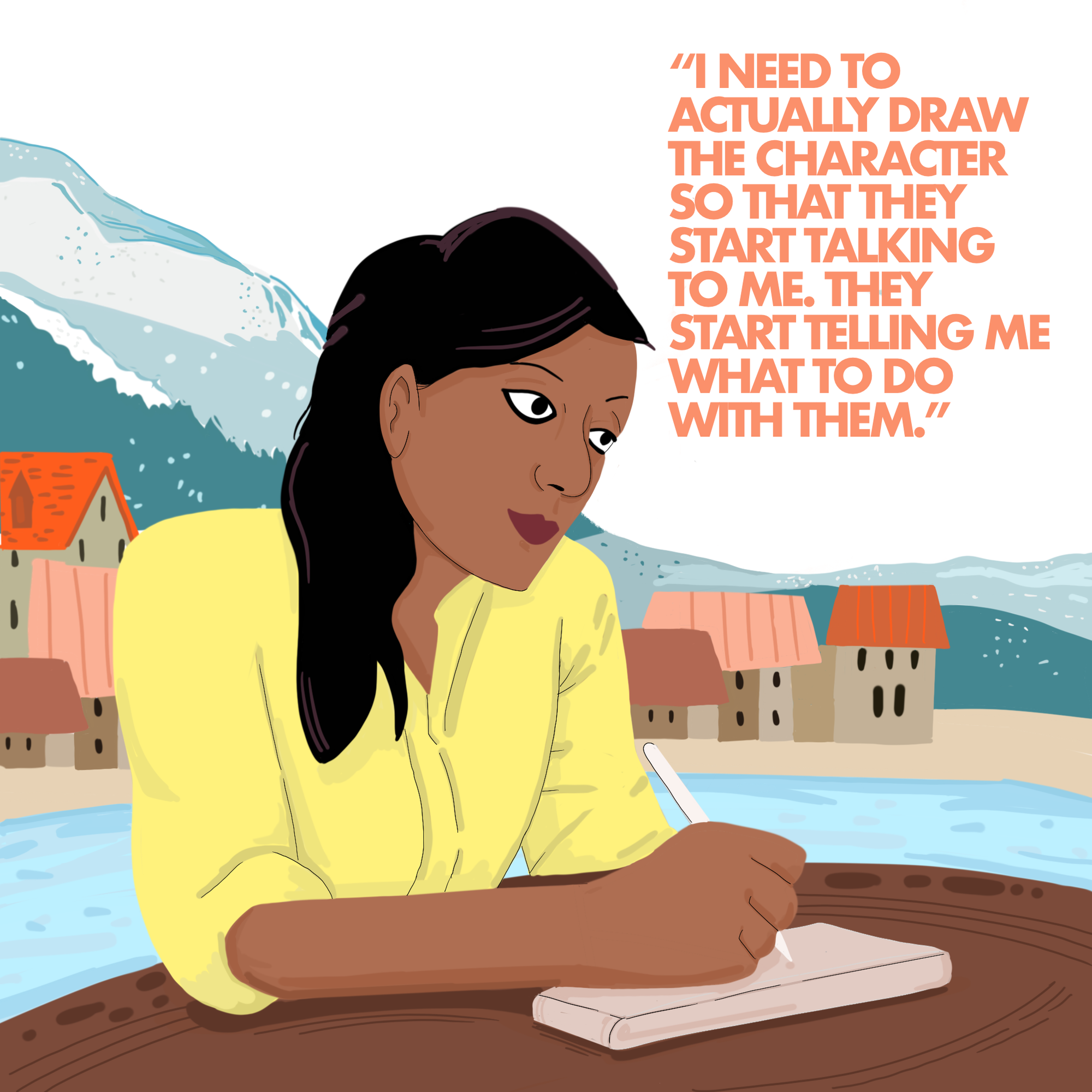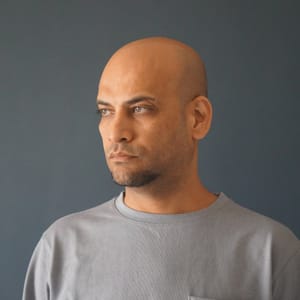
UK-based storyteller Debasmita Dasgupta’s thought-provoking writing style and assertive strokes fill up the panels of her latest graphic novel ‘Terminal 3’.
I had the pleasure of interviewing her, which turned out to be a profound learning experience for me as an artist; full of valuable insights and inspiration.
The new book narrates the gritty story of Kashmiri teen Khwab who is preparing for an international jujitsu tournament, in the turmoil filled valley, where many dreams have perished. Her relationships, desires and spirit are put to test in this gripping book. Let us hear from her.
Your latest graphic novel ‘Terminal-3’ is a journey of doubt, despair, and hope in Kashmir, narrated through the novel’s protagonist Khwab. How did you bring her to life?
It brings back a lot of memories because the seed of the story was sown around 2012 or 2013. Around that time, I had a Facebook page called ‘My Father Illustrations’, and its purpose was to share stories of fathers defending the rights of their daughters. I shared more than 350 stories from about 56 countries. While doing that I came across one story from Kashmir about this eight-year-old girl named Tajamul Islam who is a kickboxer. The girl's father was supporting her to become a national level kickboxer. If I'm not wrong, she has even represented India at international tournaments as well. That kind of gave me a different insight about Kashmir. After illustrating that story I started doing a bit more research where I found out so many incredible stories of sportswomen from Kashmir who were football players, cricketers, volleyball players, and martial artists that absolutely fascinated me. I said, we are not talking so much about these people who persevered without proper infrastructure or an academy to train. It's sheer passion, enthusiasm and love for sports that is compelling them to do all these things. So that's how the story of Khwab actually started.
You have addressed the state-of-affairs in the region with great attention and care. How did you do your research? Did you visit the state for the same?
So I have been to Kashmir only when I was a kid, as my father loved it.
I started writing the story and illustrating it by 2019-20. At that time, I couldn't visit Kashmir because there were restrictions already in place. Just before writing I did a lot of research, especially interviews with Kashmiri people, my Kashmiri colleagues, friends, and journalists who were reporting from there on a regular basis. So I also got the chance to interview organizations like UNICEF and an organization called ‘Leher’ that did a lot of work with children and child rights in the region. Because it's a graphic novel, it had a lot of visual details and needed to find out the ground realities. I was constantly asking them about those visual details. Like, what was the road? When you're walking by, what do you see around you? In fact, in one panel you will see three kids playing with a dog where they're throwing stones at the dog and abusing it. That scene was described to me by one of my colleagues from Kashmir. So those visual details were very important to me.
Some of my friends’ and colleague’s families were living there in 2019-20, so they could tell me exactly what was happening in the valley. They also shared stories of while they were growing up, and their teenage years in Srinagar. So for example, the disintegration of that mob at the end of the first chapter was described by a friend. The bus next to her bus just disintegrated in front of her, which was very common while she was growing up. They were not shocked because that was kind of normal for them. This was an eye-opening statement as even though we read and hear about these stories, there are certain undercurrent elements, which none of us belonging to conflict zones will be able to relate to.
The other realization that kept coming back to me is that teenagers want to live a normal life with normal aspirations and desires. Whether it's a love affair or having a career option. I wanted to also talk about the other side of the story. So they're not exactly inspired by one character, but they're inspired by many true events. So of course there's a lot of fictional element in it as well, but the situations are inspired by true incidents.
The story takes you on a rollercoaster of emotions relating to friendship, love, family and passion. There are some interesting narrative tropes like the use of letters to portray the love story of Noor and Yusuf. Even the use of analogies and your poetic skills shine in this book. Do you have a process to build and shape your stories?
See, every story is a different process being a graphic novelist.
When I think of a story, I first think of the visuals and the characters. I need to actually draw the character so that they start talking to me; they start telling me what to do with them. In terms of Terminal 3 it happened very organically as for so many years things were getting accumulated. I was absorbing all these ideas and they were slowly taking a shape inside me, which I was not even aware of. I think a lot of us as writers struggle to conform to structure or storytelling styles. I think sometimes when it comes out very naturally is when it's so true.
On the other hand, I do not deny there is also science in writing and crafting stories. I had a proper three act structure for developing characters. In fact, I wrote about each character including Khadija(who is Khwab’s friend’s mother), her attributes and the visual details like Khadija's face and her crooked nose. I write down all these vivid visualisations - how do I see them, their narrative arcs, the quest of each character, and more. So that was a science side of the craft, which is very important.
But the layer of metaphors and the aesthetic part came very naturally because I was soaking all those things from their environment and it took shape and form as the novel.
Your illustration style is unique. How long did you take to find your signature style?
It’s a very common question for me as I teach. My answer is that you have to see and experience many different artists. When you just get inspired by one artist and you start copying that style, then it becomes a copy. It doesn't have your style anymore, but what happens when you start observing or studying 10 different artists, then your style becomes a combination of these 10 artists. Then it's not a copy and that's how you're actually developing your style and space. When I started there was no Instagram and it was a good thing because there weren’t an overwhelming number of illustrators around you. But at the same time, it was also difficult because one doesn't know how to start or how to develop their style.
So I was a huge fan of the legendary Bengali painter Jamini Roy. His characters would have these big eyes. As a Bengali, I have always related to the Durga statues in Kolkata which are close to my heart.
So again, very naturally when I started drawing, it just happened that I will always draw big eyes, which slowly became a style and people started noticing it. So the more you practice and don't follow one school of thought, like I have also seen people from one institution
or one college, you know, So I have this habit of using mixed media. If you see my illustrations, they are done digitally but they have a texture on top of it, which is handmade. So I paint with acrylics to create those textures, which are then digitally integrated.
And for ‘Terminal 3’, I've used a lot of fabric material. If you notice, the Pashmina shawl that you see or the kurtas that she's wearing or the dupattas, the scarf, those are actually original Pashminas. So I photographed them and I've integrated them in the images. So, you know, this is what I'm trying to say that when you look at different forms you get ideas, and that's how your style becomes your style. You start owning certain decisions.
I have noticed that a lot of your protagonists are young girls. Is there a reason for that?
I mean, I'm happy that you asked this question because my upcoming graphic novel with Harper Collins is about a 10-year-old boy. It is called ‘Zardozi’, and is releasing somewhere in August or September. I was commissioned by this initiative called ‘Boyish’ run by Rajat Mittal. His whole idea was the definition of masculinity, how we define masculinity and what are those lines?
There's a lot of talk about feminism and femininity, but there is not that much talk about masculinity. Again, interestingly, this was also a topic that was playing in my mind.
So there is no such obvious reason that I only write girl stories and not boy stories. When I started my journey there weren’t many children's book featuring girl stories. So of course, I wanted to address that gap.
Interviewed by Ashwin Dutt Ponamgi
You can buy her latest book 'ZardoZi - Stitched with Love'
https://harpercollins.co.in/product/zardozi/


